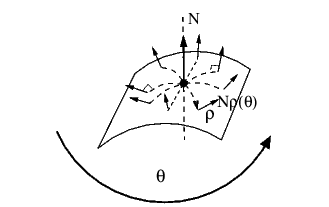
Splashes
Many local representations in object recognition systems are primitive-based.
In [2], super-segments and splashes are proposed to represent 3D curves and surface patches with significant structural changes. A splash is a local Gaussian map describing the distribution of surface normals along a geodesic circle. Since a splash can be represented as a 3D curve, it is approximated by multiple line fitting with differing tolerances. Therefore, the splashes of the models can be encoded and stored in the database.
The on-line matching of a scene object to potential model objects consists
of indexing into the database using the encoded descriptions of the scene
splash to find the best matched model splash. In [1], a three-point-based
representation is proposed to register 3D surfaces and recognize objects
in cluttered scenes. On the scene object, three points are selected with
the requirement that (1) their curvature values can be reliably computed;
(2) they are not umbilical points; and (3) the points are spatially separated
as much as possible. Then, under the curvature, distance, and direction constraints,
different sets of three points on the model surface are found to correspond
to three points on the scene objects. The transformations computed using
those scene-model correspondences are verified to select the best one.

Figure 1: The splash representation.
The angular differences between the
normals Np(O) near the central point
and the normal N at the center point
are encoded.
[1] C.S. Chua and R. Jarvis, 3D free-form surface registration and object recognition, International Journal of Computer Vision, Vol. 17, pp. 77-99, 1996.
[2] F. Stein and G. Medioni, Structural indexing: efficient 3-D object recognition, IEEE Transaction Pattern on Pattern Analysis and Machine Intelligence, 14(2): pp. 125-145, 1992.